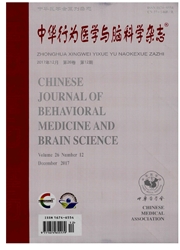

 中文摘要:
中文摘要:
目的观察颈外动脉移植骨髓间充质干细胞(BMSC)对脑挫伤大鼠神经功能恢复及学习记忆的影响。方法10只SD大鼠随机数字表法分为外伤性颅脑损伤(TBI)组和BMSC移植组。采用自由落体制作大鼠皮质运动区脑挫伤模型,将培养纯化并鉴定的BMSC于术后当天经颈外动脉移植人体内;术后1d、3d、7d、15d行改良神经功能缺失(NSS)评分,并于15d进行水迷宫测试以观察动物学习记忆能力。15d时取脑组织用免疫荧光技术检测hochest标记的移植BMSC在体内存活、迁移情况。结果脑外伤组大鼠损伤后即出现不同程度抽搐、瘫痪、平衡功能缺失,神经功能缺损评分明显升高。而BMSC移植组的NSS评分至第7天后[(6.5±1.19)分]与单纯手术组(TBI)[(8.75±0.68)分]比较明显减少(P〈0.01)。第15天进行水迷宫测试发现BMSC移植组逃避潜伏期[(20.48±2.29)s]显著优于TBI组[(85.93±47.48)s,P〈0.01]。BMSC组在目标象限停留时间百分比[(28.62±1.72)%]和路程百分比[(29.05±3.08)%]明显高于TBI组[(19.37±2.81)%,(21.78±3.06)%],均差异有统计学意义(P〈0.01)。BMSC组穿越站台次数[(8.00±2.45)次]和TBI组[(2.00±1.87)次]相比,差异也有统计学意义(P〈0.01)。免疫荧光检测显示,移植BMSC能在宿主脑组织存活,并向四周迁移。结论颈外动脉移植BMSC能在挫伤脑组织存活、迁移,并改善脑挫伤大鼠神经功能和学习记忆能力。
 英文摘要:
英文摘要:
Objective To study the effect of bone mesenchymal stem cells (BMSC) transplantation into traumatic brain injury(TBI) rats by the external carotid artery on neurological function and learning and memory. Methods Ten adult SD rats were randomly divided into TBI group ( n = 5 ) and BMSC transplantation group ( n = 5 ). Feeney free falling method was used to establish TBI models. The experimental rats were administrated with BMSC via external carotid artery (ECA) ,while TBI rats were injected with sterile liquid medium of equal volume via right ECA. Neurological function were evaluated according to the modified neurological severity score (NSS) at 1,3,7,15 days. Morris water maze test was used to observe the animal capabilities of place navigation and space exploration at 15 days, then animals were sacrificed. Survival and migration of implanted BMSC in brains under fluorescence microscope. Result After traumatic brain, varying degrees convulsions, paralysis, loss of balance function in rats were found. Compared with TBI group, BMSC transplantation decreased significantly NSS (P 〈 0.01 ). BMSC transplantation significantly decreased on escape latency( (20.48 ± 2.29 )s) than the TBI group ( ( 85.93 ± 47.48 ) s) (P 〈 0.01 ). Moreover, BMSC group in the target quadrant dwell time ( (28.62 ± 1.72) % ) and distance ( ( 29.05 ± 3.08 ) % ) as well as the number of passing the platform ( 8.00 ± 2.45 ) were significantly higher than the TBI group ( ( 19.37 ± 2.81 ) %, ( 21.78 ± 3.06) %, (2. 00 ± 1.87 ) respectively, P 〈 0. 01 ). Transplanted BMSC could survive and migrate around injury brain through Hochest mark immunofluorescence. Conclusion BMSC can survive and migrate around injury brain by transplantation of external carotid artery,which results in a significant neurological function improvement and learning and memory increase in rats with traumatic brain injury.
 同期刊论文项目
同期刊论文项目
 同项目期刊论文
同项目期刊论文
 期刊信息
期刊信息
